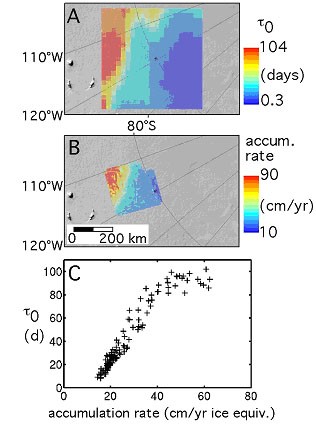Spatial and Temporal Variation of the Characteristic Time Scale of Microwave Emission with Snow Properties over Antarctica
Lora S. Koenig1, Eric J. Steig1, Dale P. Winebrenner2
1 Department of Earth and Space Sciences, University of Washington
2 Applied Physics Laboratory, University of Washington
Space-borne infrared and passive microwave sensors are ideal platforms for monitoring spatially distributed snow properties and climate variables on short temporal scales. If properly utilized these sensors have the potential to provide over two decades of valuable temperature and snow property datasets for expansive areas with sparse ground measurements.
Microwave emission is conventionally related to physical temperature via “effective emissivity”, a ratio of time-averaged brightness temperature (TB) and physical (usually, surface) temperatures. However, on sub-annual time scales, the effective emissivity is time dependent and fails to account fully for the dependence of TB on the history of surface temperatures. Winebrenner et al. (2004) derived an alternative relationship between surface and brightness temperature time series in terms of a convolution, which depends on a time scale, ?o, which is a ratio of the firn’s thermal diffusivity and microwave extinction coefficient. Determination of ?o is accomplished by minimizing the difference between the known TB measured by the SMMR and SSM/I sensors and simulated TB, based on surface temperature measurements.
Simulation of 37 GHz, vertically polarized (37V), brightness temperatures using automated weather station (AWS) temperature data yields excellent agreement with 37V observations (Winebrenner et al, 2003). Time scales range from days to tens of days, depending on location, with uncertainties of about 10%. Here, we use monthly averaged, clear sky AVHRR data (Comiso, 2000) as our surface temperature measurement, compared with 37V TB’s to diagnose ?o from 1982-1999 across the entire Antarctic ice sheet. In locations where both AWS and AVHRR data were used there was good agreement in the ?o values obtained.
Through these simulations, insight has been gained on the covariance of ?o with snow properties throughout space and time. ?o maps generated with AVHRR data in the area of Byrd Station, Antarctica mimic radar-generated accumulation maps produced by Morse et al (2002). This area shows a linear relationship between ?o and accumulation (Figure 1), for accumulation rates less than about 50 cm/year (ice equivalent). If this relationship proves valid elsewhere, then retrievals of accumulation rate using this method could yield information on sub-decadal scales since, the physical interactions of the microwave emissions at 37V occur largely in the top few decimeters to meter of firn. Temporally resolved maps of ?o display variability on a 3-yearly time scale. Whether this temporal variability tracks accumulation rate fluctuations remains under investigation.
On a continent-wide scale, ?o values in East Antarctica are generally lower than in West Antarctica. Comparison of our long term (1982-1999) ?o map with the accumulation map of Vaughan et al. (1999) suggests that, on large scales, snow physical properties in addition to accumulation rate must influence ?o.
 Figure 1 Comparison of accumulation rates and calculations of t0 for the area of the main West Antarctic ice divide near Byrd Station. (a) shows the 2700-year average data from Morse et al. (2002), (b) shows our calculations of t0, (c) compares the two as a scatter plot.
Figure 1 Comparison of accumulation rates and calculations of t0 for the area of the main West Antarctic ice divide near Byrd Station. (a) shows the 2700-year average data from Morse et al. (2002), (b) shows our calculations of t0, (c) compares the two as a scatter plot.References:
Comiso, J.C., Variability and trends in Antarctic surface temperatures from in situ and satellite infrared measurements, J. Clim., 13(10), 1674-1696, 2000.
Morse, D.L., D.D. Blankenship, E.D. Waddington, and T.A. Neumann, A site for deep coring in West Antarctica: Results from aerogeophysical surveys and thermo-kinematic modeling, Ann. Glaciol., 35, 36-44, 2002.
Vaughan, D.G., J.L. Bamber, M. Giovinetto, J. Russell, A.P.R. Cooper, Reassessment of Net Surface mass Balance in Antarctica, J. Clim., 12, 933-946, 1999.
Winebrenner, D.P, E.J. Steig, L.S. Koenig, C.A. Shuman, Probing Thermal Diffusivity and Microwave Extinction on Ice Sheet Surfaces Using Surface and Brightness Temperature Time Series. American Geophysical Union conference, San Francisco, December 2003.
Winebrenner, D.P., E.J. Steig and D.P. Schneider, Temporal co-variation of surface and microwave brightness temperature in Antarctica, with implications for the observation of surface temperature variability using satellite data, Ann. Glaciol., 39, 2004.
